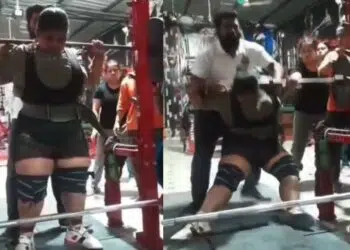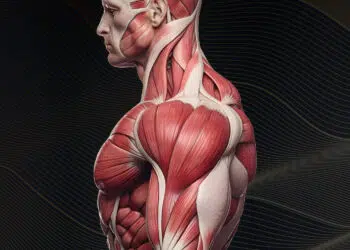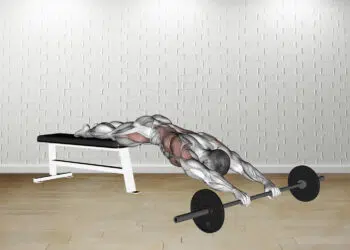The decline barbell bench press is a compound exercise that emphasizes the lower chest muscle fibers also known as the sternal head. Most exercisers probably don’t include it in their chest workouts but it does have some advantages over a flat or incline bench press which we’ll discuss in this training guide.
Many people might think it’s not a necessary exercise variation but it’s worth trying to see how your chest responds. Learn about the benefits of decline presses and try out our top variations and alternatives.
In this Exercise
- Target Muscle Group: Sternal (lower) Pectoralis Major
- Type: Strength, hypertrophy
- Mechanics: Compound
- Equipment: Decline barbell bench station or power rack with decline bench
- Difficulty: Beginner/Intermediate
How To Do The Decline Barbell Bench Press
- Setup on a standard decline bench station or power rack with spotter arms. Decline the bench at a roughly 15-30 degree angle.
- Sit on the higher end of the bench and secure your shins under the foam rollers.
- Lay back flat on the bench and grip the bar so that your hands are wider than shoulder width apart. You may have to play with your grip width slightly as arm length can also determine the ideal pressing position. Your elbows should be flared out away from your torso at a roughly 45-degree angle or more.
- Press your upper back into the bench, stick your chest up, depress your shoulder blades and flex your lat muscles.
- Slide the bar off the pegs and hold it above the nipple area.
- Slowly lower barbell until it touches your lower chest or to within a few inches and inhale.
- Squeeze your chest muscles and push the barbell toward the sky until your arms are fully extended while blowing the air out of your lungs.
- Repeat for the desired number of reps.
Watch the provided video included below to see a short demonstration of decline barbell bench presses.
Common Mistakes
These are some decline barbell bench press mistakes to avoid.
Not enough range of motion
Why shorten your range of motion on the decline bench press when it already naturally places you in a position that decreases the distance between your chest and the bar. Not to mention, it’s typically less harsh on the shoulders. You should definitely lower the bar and touch your chest to make it worth your efforts.
Not using a spotter
It may feel easier to lift more weight on the decline bench but be careful not to overestimate your strength ability. If training heavy still use a spotter to keep yourself from getting crushed by a loaded bar.
Level Up Your Fitness: Join our 💪 strong community in Fitness Volt Newsletter. Get daily inspiration, expert-backed workouts, nutrition tips, the latest in strength sports, and the support you need to reach your goals. Subscribe for free!
Bouncing the bar
There’s a difference between faster reps and bouncing the bar off your chest. Not that it won’t stimulate chest gains but you need to control the bar and its path as you complete each rep.
Benefits
Why should you include decline barbell presses in your chest training regime?
Emphasize the lower chest
While you cannot completely isolate sections of a single muscle group, you can shift where you place the emphasis by changing the angle of an exercise. In this case, declining your upper body will allow you to press along the direction of your lower sternal head fibers.
As an added bonus, a combination of factors tends to allow lifters to use more weight on the decline bench press (1). Try it out and you’ll see for yourself!
Easier on the shoulders
Decline presses are a more shoulder-friendly variation compared to a flat and especially an incline press. For that reason, many exercisers will utilize this exercise instead for their heavy pressing movement. It probably has to due with the delts being lower than the chest during the decline press and the reduced range of motion.
For some lifters, the eccentric or stretch phase of bench press bothers their shoulders and hence a common fix is to stop a few inches before the bar hits the chest.
Simulates the arched powerlifting technique
Strength athletes use a technique where they arch their back to minimize the distance between the bar and their chest. This places them at a declined angle similar to the decline barbell bench press which allows them to lift heavier weight and have a better chance at completing a rep.
Powerlifters can find this exercise to be a useful training tool for their max competition lifts.
Do something different
Training boredom is a real thing and it affects all of us every now and then. Decline presses may not be the most popular variation but they are a way to challenge yourself and possible stimulate new growth in your pecs!
It’s a barbell bench press
While it’s not everyone’s favorite Monday chest builder aka the flat barbell bench press, it’s still a bench press. If you’ve ever trained at a crowded gym chances are all the flat bench stations are occupied and not likely to be free anytime soon.
Decline bench stations are typically the least popular of the freeweight bench variations and it’s a great way to load your pecs on chest day. There may be a misconception that declines only work the lower chest but they still work the full chest including the upper and middle as we discussed you cannot isolate one part with any movement.
Drawbacks
Now let’s talk about some of the drawbacks of decline barbell bench presses.
A little awkward
If you’re new to decline presses it will take a little getting used too. Not just because you’ll be more in an upside position with your head lower than your chest but you’ll notice that it takes more stabilization to keep the bar in the right spot as it will want to wobble more than you’re used too. However, once you get it down it shouldn’t be an issue.
Not for everyone
Because you’re in a somewhat upside down position, you’ll immediately feel more blood rushing to your head. Some people may find this to be very uncomfortable and not worth it. In that case, we recommend trying an upright machine variation such as the Hammer Strength decline press also included in our best variations section.
No leg drive
With the decline bench press, your feet are several feet off the ground and you, therefore cannot take advantage of leg drive to assist your pushing efforts.
Level Up Your Fitness: Join our 💪 strong community in Fitness Volt Newsletter. Get daily inspiration, expert-backed workouts, nutrition tips, the latest in strength sports, and the support you need to reach your goals. Subscribe for free!
Variations and Alternatives
Below we’ve picked out our favorite decline chest exercise variations that have advantages over the freeweight barbell decline press.
1. Dumbbell decline press
The dumbbell decline press offers you more freedom of movement and increased stabilizer muscles recruitment. However, the one drawback is that you have to lift the weights higher to get them in the starting position. If you want to use heavy dumbbells, we recommend having someone hand them to you, and take them away when you’re done with a set.
Related: Lower Chest Dumbbell Exercises: Build a Big, Strong Lower Chest
2. Decline machine press
Utilizing machine exercises such as the Hammer Strength decline press or similar variations that are performed in an upright position make this movement more user-friendly. Declining your upper body will cause blood to rush to your head and for some people it’s not ideal.
Plus many do prefer this variation as they feel more of a contraction in the lower pecs which results in a better overall workout.
3. Decline dumbbell/barbell floor press
If you don’t have access to a decline bench, you can do decline presses from a glute bridge position on the floor. You can use a pair of dumbbells or perform it with a barbell from a power rack.
4. High to low cable flys/crossover
A great alternative option to the decline barbell bench press is a high to low cable fly. You won’t be able to load the pecs with as much weight but you do get the enhanced stretch across the length of the muscle fibers and more activation of the chest fibers through arm adduction.
Fly variations in general should be included in every serious chest workout routine for maximum pec development.
Here’s a full high to low chest fly training guide.
5. Incline pushups
You can easily replicate a decline bench press with a bodyweight push-up by elevating your upper body up on a platform several inches from the floor or on a Smith machine adjusted to the appropriate height.
6. Dips
Dips especially on a power tower will also hammer your lower chest muscles plus it’s one of the best triceps focused exercises. You can also wear a weighted dipping belt or hold a dumbbell between your feet to add more resistance and hence make more gains!
Program Decline Barbell Bench Presses in Your Workouts
The beauty of training for hypertrophy (muscle growth) is you can change up the order of your exercise to stimulate new growth using different exercise variations.
Decline barbell presses are a straightforward exercise that you can include at the beginning, middle, or end of your chest workout routine, ideally before the isolation movements. If you feel your lower pecs are underdeveloped, we recommend prioritizing them first sometimes in your workouts.
Try out these lower chest workouts and exercisers for a sculpted chest.
Sets and Reps
There’s no such thing as a perfect sets and reps range for everyone. Your level of training experience and workout goals will ultimately determine how much training volume you do or how you structure your training sessions. However, we always recommend using a variety of rep ranges.
- Strength: 3-5 sets x 3-5 reps
- Hypertrophy: 2-4 sets x 6-20 reps
- Hypertrophy and muscle endurance: 15-30 reps
Muscles Worked
- Pectoralis Major Sternal Head – Also known as the lower chest, the pectoralis sternal head is a separate section of muscle fibers that assist in pulling the arms downward. Decline bench presses replicate this function and are hence used to emphasize the lower chest muscles.
- Pectoralis major clavicular head – clavicular or upper portion of the chest causes flexion of the extended arm. Decline presses still activate the upper chest muscles although it’s not the priority.
- Triceps brachii – The triceps is a three-headed muscle on the back of the upper arms. They primarily function to extend the elbow and help support the body’s weight during push-ups, bodyweight exercises and weighted presses.
- Deltoids anterior – The deltoid anterior or front deltoids is one of the three heads that make up the shoulder muscles. This muscle is involved in arm flexion, stabilizing the arm while the deltoid lateral abducts the arms (raise the arm away from the midline of the body). It also works with the pectoralis major to flex the arm when walking.
- Core muscles – The core consists of several muscles – abs (curls the pelvis and rib cage toward each other), obliques (located on either side of the abs and rotate the torso), deeper core muscles (transverse abdominis and internal obliques draw the belly button to the spine and stabilize the trunk), back extensors (allow us to stand up straight from a bent-over position and lean backward). Any compound exercise will require full core activation.
Decline Vs Flat Vs Incline Bench Press For Lower Chest Activation
There’ve long been comparisons between the three bench press angles – flat, incline and decline. We can tell you that all three will work the entire chest as there’s no way to single out a specific section of a single muscle group ( e.g., upper, mid and lower) (1). However, research has shown that angle/bench position can influence chest activation to a degree (no pun intended).
For example, one 2015 study compared chest activation between 0, 30, 45, and -15 degree bench angles. (2). Researchers found that a 30 degree incline elicited greater upper pec activation while the flat and decline bench press were superior for total activation of the lower chest.
Takeaway: If you want to maximize lower chest gains the decline and flat bench are the way to go.
Bottom Line
If your lower pecs are lagging or you want more chest growth then it may be worth including a few sets of decline barbell bench presses or its variations in your workouts.
They offer a very shoulder friendly way to build pec mass and strength and whether you’re a bodybuilder or are just looking to maximize your muscular potential, you’ll get the best results by hitting the muscles from different angles using a variety of exercises like decline presses.
Interested in measuring your progress? Check out our strength standards for Bench Press, Push Ups, Floor Press, and more.








